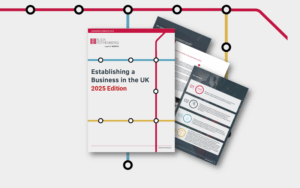Tax Q&A: Property and partners
Taxation of income from property can be complex, particularly when it is owned by a couple. Here, Blick Rothenberg’s Robert Salter breaks down how it works.
Q: I hear the tax treatment of couples’ income from property can be a little complicated. Where do we start?
The default starting assumption when looking at the letting income from jointly owned property is that the profit from the property is taxable on an equal 50/50 basis between the spouses (assuming the couple are married or in a civil partnership).
From a tax perspective, the above approach does, however, potentially result in some “tax inefficient” results – e.g. where one spouse is taxable at 40% or 45% and the other individual doesn’t work and has an unutilised personal tax allowance available (or is taxable only at 20%).
Q: So, is it possible to change the profit split for letting property that is jointly owned by spouses or civil partners?
Yes – potentially. However, it is necessary to understand how the property is actually owned by the spouses or civil partners. That is, whether the property is owned as joint tenants or tenants in common.
Joint tenancy means that the whole property is owned jointly by the partners as “one entity”. This means that when one partner dies, for example, the whole property automatically transfers to the remaining partner. Neither partner, in effect, owns a particular share of the property – rather they just own the property in full but on a strictly joint basis. In contrast, tenants in common each own a particular proportion of the property.
For example, one partner could own 80% of the property and the other party could own the other 20%. It is possible that each partner could sell their portion of the property separately. For Inheritance Tax (IHT) purposes, the element of the property that they own as a tenant in common goes into their individual inheritance tax estate.
Q: What does the difference between joint tenants and tenants in common mean from a letting income perspective?
In simple terms, if the property is owned as joint tenants, it will not be possible to amend the letting income profit apportionment between the two spouses or partners. The assumption that they each own 50% of the profit cannot directly be altered in the first instance. Rather, one would need to look to change the whole basis under which the property is owned and become tenants in common legally – this change, however, is a legal issue and would potentially require guidance from a lawyer.
In contrast, if the property is owned as tenants in common, each spouse or partner owns a specific, share of the property and it would be possible to alter the beneficial ownership share of each individual (and ensure that one is subject to income tax based on only one’s share of the beneficial ownership).
Q: How can you amend the partnership profit share of the spouses or partners for tax purposes?
Firstly, clearly it would be necessary to change the beneficial ownership in the property, so that one partner (the higher rate taxpayer), owns a reduced share of the property. This could require legal advice and the completion of a declaration of trust to transfer the property ownership.
Issues can also arise if there is a mortgage on the property, as any change in ownership structure will need the approval of the building society or bank before it can go ahead. In addition, care needs to be taken from a Stamp Duty Land Tax (SDLT) perspective where there is a mortgage involved, as any ownership transfer would trigger SDLT in such cases.
Secondly, it is important that one files a formal declaration (Form 17 – Declaration of Beneficial Ownership in Jointly Owned Property & Income) with HMRC to record the underlying beneficial ownership structure.
If one does not file the Form 17 declaration, the tax position remains that each spouse or partner is taxed on a 50/50 basis for income tax purposes.
Q: What is the position if the couple are not formally married or civil partners?
Where property is owned jointly by an unmarried couple (e.g. in a so-called common law marriage), income etc will still be taxed on a 50/50 basis where the property is held by the couple as joint tenants.
However, where the property is owned as tenants in common and the couple are not married or civil partners, for income tax purposes, the income would be split in accordance with each person’s underlying share in the property.
Q: What happens if the property is owned indirectly – e.g. via a limited company rather than directly in the name of the spouses or partners?
If a UK letting property is owned via the spouses or partners through a limited company structure, the underlying income tax position for each partner will depend on:
- The retained profit of the business;
- The dividends the company decides to pay; and
- Whether one individual has been working in the business and is entitled to draw a salary for this work.
In practice, it may be easier to apportion the overall income from a letting business tax efficiently, where it has been undertaken via a limited company. This is on the basis that if one partner (specifically the partner being taxed at a lower rate of tax) is active in the letting business (e.g. as a company secretary, but also perhaps handling tenant enquiries etc.), it would be perfectly valid for the individual to draw a separate salary from the business, providing that this is reasonable given the nature of the activities undertaken.
Moreover, as advisers will be aware, there are a number of other advantages that can arise (such as re-mortgage interest relief), when the business is undertaken through the use of a limited company.
Q: Can you sum this up?
In summary, when dealing with income from the letting of property, it is important for advisers to:
- Understand how the business is owned – e.g. as a limited company or privately by the spouses or civil partners;
- Understand if the property is owned directly by the individuals concerned and clarify whether this is as joint tenants or tenants in common;
- Not make assumptions as to whether the owners are married (or civil partners) or not – specifically clarify their status;
- Understand whether there is any mortgage on the property or properties; and
- Remember that whilst a limited company structure does have potential advantages from a tax perspective, consider issues such as CGT if you are looking at transferring let property into a company.
If you would like to discuss any of the above, please get in touch with Robert Salter using the details on this page.
For press enquiries please contact David Barzilay.

You may also be interested in

Unlocking Growth: What the Government’s 2025 Industrial Strategy Means for the UK’s Creative Sector

A ray of hope for the Property Market: HMRC transaction data suggests recovery momentum













